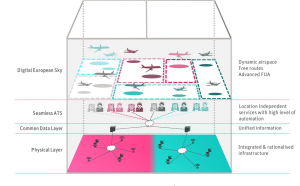Air Traffic Management needs to change. The current European ATM system is a patchwork of national infrastructures that is not able to efficiently absorb additional air traffic including new forms of aviation such as Urban Air Mobility and drones. With the expected increases in traffic, the current system will soon become unsustainable. The future of ATM is a collaborative distributed system with a much greater level of interoperability between control centres and with airports. This future is predicated on the creation of a common data layer that enables a location independent provision of ATM. In this series of blogs, our ATM experts will explain how this common data layer can revolutionise ATM provision, both en-route and at airports, what the potential benefits are and the current barriers to a successful transition.
Emerging Challenges
Before getting to the what, lets first discuss the why. Historically, across Europe, ATM has never really had sufficient capacity – we know this because EU wide delay targets have seldom been met – but most ANSPs in Europe do not add delay to the system. The reality is that capacity can only be delivered where it is deployed – Europe has insufficient capacity on some areas and excess capacity in others. Further, at periods of high traffic growth, the ATM system is not flexible enough to quickly increase capacity, leading to high delays and extended flight distances to avoid congested areas.
 As the 2020’s begin, it is also clear that aviation is facing an existential crisis. The global mobility enabled by aviation is a key enabler of the United Nations Sustainable Development Goals (SDGs), in particular in terms of improving logistics, reducing waste from farm to plate and supporting education and global cultural awareness. But aviation is also one of the most visible forms of carbon emissions – leading to significant pressure to reduce greenhouses gasses. If aviation is to be carbon neutral then big strides are needed in aircraft design and bio-fuels, but there are three objectives that need to be designed in the future of ATM:
As the 2020’s begin, it is also clear that aviation is facing an existential crisis. The global mobility enabled by aviation is a key enabler of the United Nations Sustainable Development Goals (SDGs), in particular in terms of improving logistics, reducing waste from farm to plate and supporting education and global cultural awareness. But aviation is also one of the most visible forms of carbon emissions – leading to significant pressure to reduce greenhouses gasses. If aviation is to be carbon neutral then big strides are needed in aircraft design and bio-fuels, but there are three objectives that need to be designed in the future of ATM:
- The future ATM system must understand and enable the best trajectory for all flights – this means greater focus on communicating with airspace users rather than relying on regulatory proxies such as the environmental metrics used by the current SES performance scheme.
- The future ATM system needs to be rationalised. Sustainability for all industries means less is more. The minimum infrastructure needs to be deployed to deliver a resilient service.
- The predictability of aviation needs to improve to allow customers to optimise door to door journeys through multi-modal ticketing. Sustainable transport requires passengers to be able to make informed choices.

Achieving these environmental objectives is going to require significant operational and technical change that will also need to consider changing mobility requirements and in particular, how to accommodate new forms of airspace user – such as drones and super high altitude vehicles. This opens up new airspace – in particular to enable Urban Air Mobility and therefore the opportunity to design new services specifically for different types of mission – for example, preventing unauthorised access or enabling formation flying.
![]() The third challenge is to embrace the disruptive technologies that have had such a transformative impact on other sectors – be it UBER, AirBnB or Spotify. ATM has always been a data rich environment – but by adopting modern digital technologies including Artificial Intelligence, new forms of automation will be possible leading to increased efficiency.
The third challenge is to embrace the disruptive technologies that have had such a transformative impact on other sectors – be it UBER, AirBnB or Spotify. ATM has always been a data rich environment – but by adopting modern digital technologies including Artificial Intelligence, new forms of automation will be possible leading to increased efficiency.
Available Opportunities
The SESAR Joint Undertaking Airspace Architecture Study sets out a high level proposal for the future architecture of ATM that addresses these three challenges. As illustrated in the figure, it envisages a collaborative approach at different layers to deliver a truly Single European Sky.

The aim of the AAS is to promote a network centric pan-European ATM system that enables airspace to be designed on traffic flows and managed dynamically leading to operational efficiency.
In the remainder of this blog series, we are going to explore the what and how for achieving the AAS:
- In part 2 we will look at en-route ATS and how the virtual centre concept enables location independent services leading to more flexible and dynamic ways of balancing demand and capacity across ANSPs.
- In part 3 we will consider the opportunities that a common data layer provides to the airport domain and how the “Digitally Connected Airport” might look in the future.
- In part 4 we will look in more detail at the common data layer itself, what it means operationally and how ATM data services might be provided.
- In part 5 it is the turn of the human – how will ATCO and engineering roles change?
- Part 6 looks at the transition and in particular how to pay for all this change.
- Finally in part 7, we look at the barriers to a successful transition.


Author: Conor Mullan, Managing Director Author: Paul Ravenhill, Technical Director


Recent Comments